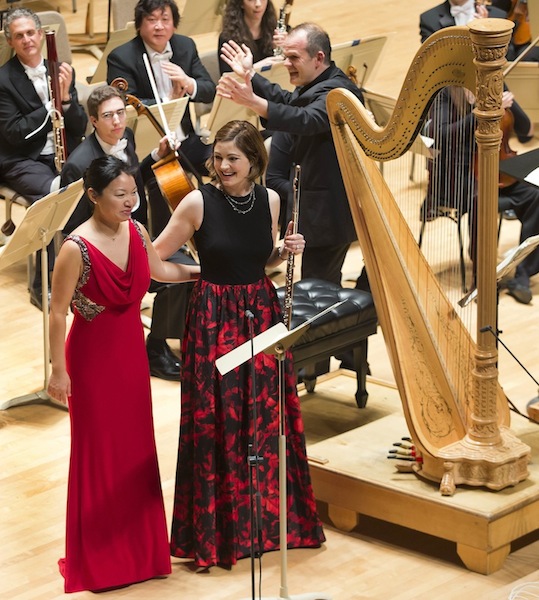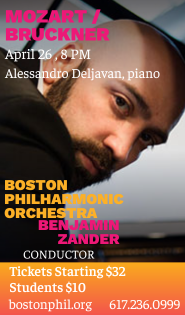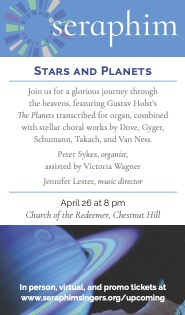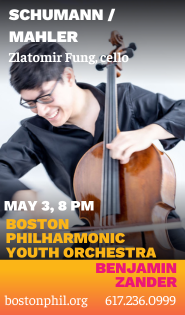Roth, BSO open French doors to the classics

Elizabeth Rowe and Jessica Zhou take a bow following their performance of Mozart’s Concerto for Flute and Harp with François-Xavier Roth and the Boston Symphony Orchestra Thursday night. Photo: Winslow Townson
During a week that marked the death of the great composer and conductor Pierre Boulez, a French maestro brought a touch of Boulezian rigor to the Boston Symphony Orchestra.
During the final bows at Thursday’s concert of works by Gossec, Mozart, and Beethoven, conductor François-Xavier Roth spoke to the audience, noting the passing of his countryman and indicating his intention to dedicate his concerts with the BSO the following week to Boulez’s memory.
But it was the performance just concluded, a brisk, transparent, and incisive reading of Beethoven’s Symphony No. 3 (“Eroica”), that paid tribute to le maître more aptly than any words printed in the program.
In this rendition of a symphony famous (even notorious) for its grandeur and length, the first movement’s exposition flew by so fast that repeating it became not a choice but a necessity. (The repeat also allowed the players to synchronize a bit better than the first time around.) The wild diversity of musical ideas that one early listener described as “utter confusion” came on with relentless force, a river in flood.
At the same time, the movement’s climactic crescendos were expertly managed, to stunning effect, and the moments in more relaxed tempos became oases of reflection. The funeral march had dignity, but forward momentum as well. Roth neglected neither the movement’s many pauses and hesitations nor its flashes of searing drama. The scherzo’s pianissimo opening was charged with excitement, and its sudden syncopations popped like corks in the fast tempo. The trio’s three horns yelped raucously at first, then mellowed and receded effectively.
The finale too emphasized speed over grandiosity, the better to highlight the tenderness and breadth of the Poco Andante section. The orchestra’s principal string players shone as a solo quartet in the movement’s first two variations, and thereafter Roth’s ear for mixing orchestral colors was everywhere in evidence, right down to the snappy and satisfying coda.
The Beethoven performance was preceded by two items of unusual interest: the first-ever performance by the BSO of music by the Classical-era composer François-Joseph Gossec, and a concerto featuring two popular members of the orchestra, flutist Elizabeth Rowe and harpist Jessica Zhou.
The long-lived Gossec (1734-1829) was a survivor in more ways than one. Not only did his lifetime bridge the Baroque, Classical and Romantic eras—he knew and worked with Rameau, yet outlived Schubert and Beethoven—but his career flourished right through France’s aristocratic, revolutionary, imperial, and democratic régimes.
A co-founder of the Paris Conservatoire, Gossec helped establish the French dominance in playing wind instruments that lasted through the 19thcentury and beyond. In his Symphonie à 17 parties (Symphony for 17 Parts), 12 of the 17 instrumental parts are for woodwinds, horns, or trumpets (string sections and timpani make up the balance), and this emphasis on the wind band makes the piece a different animal from any symphony by Haydn or Beethoven.
Though composed in 1809, the year of Haydn’s death and three years after the publication of Beethoven’s “Eroica,” this last of Gossec’s symphonies has a quirky, witty personality that looks straight back to Rameau. In Thursday’s performance, the BSO players seemed a little at sea with it. Even their synchronization, normally so precise, was somewhat off as Roth, conducting (like Boulez) without a baton, tried to coax Gossec’s unfamiliar syntax out of them with micro-gestures.
The tender Larghetto, with its smoother lines, pulled together better as Roth moved it with a steady pulse. A lively beat also propelled the remarkable minor-key minuet through a thicket of fugal textures, and a Haydn-like spirit enlivened the finale, with its showy writing for winds. All in all, it wasn’t a bad first time for the BSO with this significant but unfamiliar composer; unfortunately, it was likely also the last time for quite a while.
The much-anticipated appearance of BSO principals Rowe and Zhou in Mozart’s Concerto for Flute and Harp, K. 299, proved somewhat disappointing, acoustically at least. The work, composed (as Jan Swafford’s program note tactfully pointed out) for a Parisian drawing room, sounded somewhat lost in Symphony Hall, like a distant conversation dimly overheard.
The two players, who on many previous occasions have demonstrated that they can fill the hall with their tone, were at a disadvantage on Thursday, for different reasons: Zhou dealing with Mozart’s intricate, piano-style writing mostly in her instrument’s upper register, and Rowe apparently trying not to blow the harp away with robust flute tone—the very quality that BSO aficionados like about her playing.
Happily, the concerto’s divine Andantino movement suffered the least from this problem, as Rowe’s flute soared in heart-swelling arcs over Zhou’s angelic ripples. And the two players sounded to best advantage in each of the three movements’ solo (duo) cadenzas, which were not by Mozart—who left none for this piece—but (mostly) by the 20th-century Dutch composer and musicologist Marius Flothuis, who did well by both instruments.
Roth’s orchestral accompaniment was exemplary, and the elegant phrasing and virtuoso skill of the two soloists were never in doubt, even when viewed through the wrong end of the telescope. Maybe they should relocate this performance to the lobby of the Copley Plaza.
The program will be repeated 8 p.m. Saturday and Tuesday. bso.org:617-266-1200.
Posted in Performances



